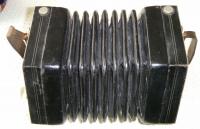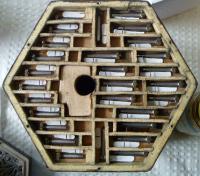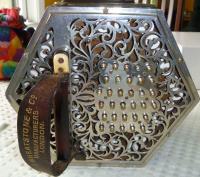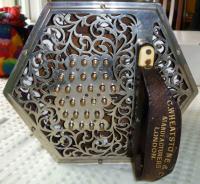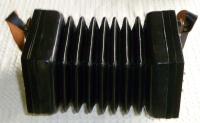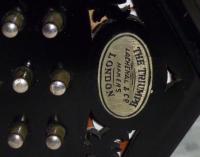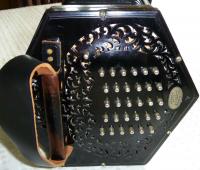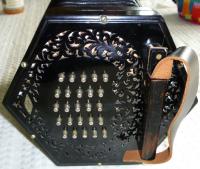
Craig Wagner
Members-
Posts
65 -
Joined
-
Last visited
Contact Methods
-
Website URL
http://www.musemusic.org
-
ICQ
0
Profile Information
-
Interests
Anglo concertina, especially Irish and exploring chording.... I have a Baritone that I love to use for backup...<br><br>Traditional Irish music...<br><br>Piano, especially blues, Boogie Woogie and improvisation...<br><br>Using music to support environmental efforts. See www.musemusic.org
-
Location
Near Ann Arbor, Michigan
Recent Profile Visitors
1,844 profile views
Craig Wagner's Achievements

Advanced Member (3/6)
-
I've updated the orginal post with links to two more pictures (reeds on the 2nd side and one picture of the action)... Any further ideas on what we have here would be appreciated! Thanks, Craig
-
Now that's what I like to see, some community sleuthing here! I'll get some additional pics that may be of value. My guess is that the handles are not original to the instrument. Note that the top of the concertina has the thumb screws for tightening the strap (like a Jeffries), but the handles have the tightening screw for the strap on the bottom... More ideas welcomed! Thanks, Craig
-
I've added more pics to the original listing and have set a $2500 price. Thanks, Craig
-
Andrew, I've looked and there is no C&S number stamped into the bar on either strap. The bars have worn, and at one point repainted. I can't say for certain if they are the original bars, but I suspect they are since they seem to be fairly well fitted to the raised wooden ends and I can't see the point of ever replacing them. The serial number #3889 on the metal insert on the outside, is also stamped onto reed pan and the bellows frame. Hope this helps. Thanks, Craig
-
ocd, I updated the original posting with a page reference to a pdf on the site with the exact layout. Please let me know if you need anything else. Thanks, Craig
-
Note: posting recently updated with more pics... Greetings. I am selling a 60b MacCann duet (32 treble + 28 bass). The instrument was fully refurbished in 2006 by the button box (new bellows, pads, valves) and I haven't played it since then. To accommodate the large number of buttons the concertina is a bit bigger than a standard box, measuring 7 inches across the end. The steel reeds give a nice sweet tone. Normal wear for a vintage instrument. The straps are original C. Wheatstone & Co. I've looked inside the concertina but there are no markings to indicate Wheatstone or otherwise. I'm selling this because I've never invested the time to learn the MacCann system. I gravitated toward the Jeffries Duet system and didn't want to get my brain wrapped around another duet button scheme. It has been sitting in it's box unplayed in my living room for the last six years since the refurbishment and I wanted to get it out to someone who would play it. For a button layout, see page 23 here. This 60 button concertina is exactly like that layout of the 62 button on this page except does not have the G#2 and the G2 shown in the dashed circles above the first two columns of buttons on the treble side. For a couple of more pics look here and here. Please see pics attached and let me know if you have any questions. I'm asking $2500 for the box. Thanks, Craig
-
Greetings... I just posted for sale a 55b Crane Duet... Please let me know if you are interested... I'm in the states but can ship safe & insured... Thanks, Craig
-
Lachenal “Triumph” Duet concertina. Completely refurbished in mechanics, cosmetics and tuning in October, 2006 by the Button Box, and hasn't been played since. A somewhat rare larger version with 55 keys (30 in right and 25 on left) plus air button. Gorgeous raised wooden ends, 7 fold-bellows, steel reeds. Instrument # 3889 is clearly marked on a metal plate on the left side of the concertina. In looking for concertina dating information, a rough cut estimation yields 1921 as the manufacturing date. The same number is stamped on the reed pans. There are minor scratches and scuffs as would be expected from of an instrument of this age, but it is in amazingly quite good cosmetic shape. The bellows are air tight. When I buy concertinas, I always look for mellow and rich tones – and that is why I got this one. I also really like the feel of the buttons on this instrument – smooth and solid. A wonderful instrument for solo play and for ensembles – it won’t blow-out the other players in your group. In excellent shape, ready to play. In perfect tune, A=440. It is a Crane tuning system can was adopted by the Salvation Army under the name “Triumph” from 1912, and eventually Wheatstone was claiming it was because of “the disposition of the keys being more suited to the playing of sacred music”. For background on Triumph duets, see http://www.concertina.com/crane-duet/. For the button layout, look at the “55 stud” diagram in here. It has been outside of it's box about 5 times since I had it refurbished. Price is $3150 plus insurance and shipping. If sold through Concertina Net, I’ll make a donation to Paul for his great work on our collective behalf. Please let me know if you have any questions. Thanks, Craig Wagner
-
Old-problem - definitive answer please
Craig Wagner replied to Warcorrespondent's topic in Buy & Sell
I'm glad you have the Custom #2. I've tried them all and really like this one. Let the war continue. Craig -
wood one? Metal or Wood...
-
OK, its just our secret... What shouldn't I tell him?
-
All, I'm looking for an Ab/Eb Jeffries (I've seen the one at the Button Box, but it seems like a very steep price). Any leads? I'm connecting with Chris Algar as well. Thanks, Craig
-
Thanks for the heads-up... I have an Edgley that I really love. Great instrument, solidly built, fast action, and at a good price. Let them proliferate! Onward, Craig
-
Brad, I keep one of my concertinas next to the bed and will play it laying down before I go to bed. It is an anglo and it is quite easy to do (that is if you play anglo!)... In fact, I've fallen asleep a few times while playing... Those are VERY restful nights! You can't go as fast, perhaps as when sitting, but it is still very doable. Onward, Craig
-
All, I wanted to share with you a delightful concertina experience that I had today. But, before I do that, let me digress. In addition to a standard CG, I've played a Baritone Anglo CG for about 3 years now, made by Colin Dipper. The depth of the low tones are fairly stunning to my ears, and for those familiar with Colin's work, you probably appreciate that it is an incredible instrument. My standards for the sounds of Baritone are probably fairly high. With a Dipper as a standard, Frank Edgley handed me a concertina today and asked me to take it for a test drive. It was a concertina that he was ready to box up and send off to a customer. I first looked at it and it had his typical fine craftsmanship. This one had highly polished metal ends, deep amber wood sides and his standard great bellows. It was the standard CG size and weight. Imagine my surprise, when I pulled my first chord, and out jumped a Baritone! Yes, a full octave below a standard CG in the size of a standard CG concertina. If you would have asked me in advance, I would have told you that I would have been skeptical about sound quality. I've had the ends off of my Dipper Baritone and there are some mighty big reed chambers. I would have thought those big chambers were needed to capture a big fat sound. But, the sound was warm, deep and buttery! I think the best chord on a CG Baritone is a G chord built on the foundation of the kick-butt low G. I pulled on that chord and out came a chord that was not a lot different from my Dipper. I was surprised in that the low accordion reeds sound a lot like the steel concertina reeds - the lower you went, the more, at least to my ears, it sounded like the reeds of my Dipper. After playing if for a while, I noticed that it was easier to manage than my Dipper because it was a standard size and weight. Normally, playing a Baritone is a bit more labor intensive than a standard CG - the more labor intensive the faster you try to play. I also noticed that the box required a playing style very close to the style demanded by my Dipper. Basically, what I mean is that you have to coax the very lowest reeds a bit, starting with a small volume of air through the reed to get it going, and once it is vibrating, you can then get more aggressive and rip off a nice chord. So, it played like my Dipper. If anything, Frank's concertina reeds perhaps spoke a tad faster than the Dipper. And, for those of you who have played Frank's standard CG, I think you might agree that there probably isn't a faster action anywhere. To my knowledge, this is the first Baritone in a standard CG size. I asked him how he did it, and basically he went back to his reed maker and had them specifically design reeds that would fit into a standard size. My recommendation: A very strong instrument - and the only one on the planet that I've seen at that size. Have you seen others? I forgot to ask him what he is charging for it, but suspect it isn't much more than his standard concertinas. Am I going to sell my Dipper? No. But, its hard for me to imagine a nicer Baritone in that price range, well crafted and available in 6 months. For those of you who have a bad case of concertina envy, this is a wonderful 2nd concertina. When I go to sessions, I typically bring two concertinas. My main squeeze CG and the Baritone. The Baritone offers the ability to add great depth to a session (all the whistles, fiddles, concertinas and pipes in the high range need some good balance!). Perhaps you want to try chord vamping as your next thing to try at your sessions. Enjoy! Craig Wagner


